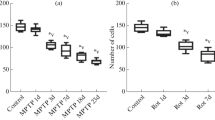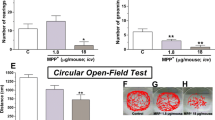Summary
In Experiment 1, groups of mice were administered either saline or MPTP (2 × 30mg/kg, s.c., separated by a 24-hr interval) 30min after being injected either PBN (15, 50 or 150mg/kg, s.c., low, medium and high doses, respectively) or L-Deprenyl (0.25 or 10.0mg/kg, s.c., low and high doses, respectively), the reference compound used, or saline. Tests of spontaneous motor activity 14 days later indicated that the MPTP-induced hypokinesia for locomotion and rearing was alleviated by prior administration with PBN (50 or 150mg/kg) or L-Deprenyl (10.0mg/kg); lower doses of PBN (15mg/kg) and L-Deprenyl (0.25mg/kg) did not affect the MPTP-induced deficits. Dopamine (DA) concentrations in the striatum confirmed a more severe loss of DA in the MPTP, PBN(15) + MPTP and Deprenyl(0.25) + MPTP groups than in the control group. Significant protection of DA was observed in the PBN(50) + MPTP, PBN(150) + MPTP and Deprenyl(10) + MPTP groups that did not exhibit an hypokinetic behaviour. In Experiment 2, the effects of repeated treatment with PBN (50mg/kg, s.c. over 12 days), post-MPTP, were studied in aged (15-month-old) and young (3-month-old) mice. Subchronic administration of PBN increased substantially the motor activity of old and young mice that had received MPTP. Aged control (saline) mice showed an activity deficit compared to young control mice; this deficit was abolished by repeated PBN treatment. The results suggest that moderate-to-high doses of PBN whether injected in a single dose prior to MPTP or subchronically following MPTP injections may afford protective effects against both the functional changes and DA-loss caused by MPTP treatment, possibly through an antioxidant mechanism.
Similar content being viewed by others
References
Ammassari-Teule M, Fagioli S, Rossi-Arnaud C (1994) Radial maze performance and open-field behaviours in aged C57BL/6 mice. Further evidence for preserved cognitive abilities during senescence. Physiol Behav 55: 341–345
Archer T, Fredriksson A, Jonsson G, Lewander T, Mohammed AK, Ross SB, Söderberg U (1986) Central noradrenaline depletion antagonizes aspects of d-amphetamineinduced hyperactivity in the rat. Psychopharmacol 88: 141–146
Beai MF, Brouillet E, Jenkins BG, Henshaw DR, Rosen BR, Hyman BT (1993) Age-dependent striatal excitotoxic lesions produced by the endogenous mitochondrial inhibitor malonate. J Neurochem 61: 1147–1150
Beal MF, Henshaw DR, Jenkins BG, Rosen BR, Schulz JB (1994) Coenzyme Q10 and nicotinamide block striatal lesions produced by mitochondrial toxin malonate. Ann Neurol 36: 882–888
Birkmayer W, Knoll J, Riederer P, Youdim MBH, Hars V, Marton J (1985) Increased life expectancy resulting from addition of L-deprenyl to Madopar treatment in Parkinson's disease; a long-term study. J Neural Transm 64: 113–127
Björk L, Cornfield LJ, Nelson DL, Hillver S-E, Andén N-E, Lewander T, Hacksell U (1991) Pharmacology of the novel 5-hydroxytryptaminelA receptor antagonist (S)-5-fluoro-8-hydroxy-2-(dipropylamino)tetralin; inhibition of (R)-8-hydroxy-2-(dipropylamino)tetralin-induced effects. J Pharmacol Exp Ther 258: 58–65
Carney JM, Floyd RA (1991) Protection against oxidative damage to CNS by alpha-phenyl-tert-butyl nitrone (PEN) and other spin-trapping agents; a novel series of nonlipid free radical scavengers. J Mol Neurosci 3: 47–57
Carrillo M-C, Kanai S, Nokubo M, Kitani K (1991) (−)-Deprenyl induces activities of both superoxide dismutase and catalase but not of glutathione peroxidase in the striatum of young male rats. Life Sci 48: 517–521
Chen G, Bray TM, Jansen EG, McCay PB (1990) Excretion, metabolism and tissue distribution of a spin trapping agent, d-pheny-N-tert butylnitrone (PBN) in rats. Free Radie Res Commun 9: 317–323
Cheng HY, Liu T, Feuerstein G, Barone FC (1993) Distribution of spin-trapping compounds in rat blood and brain; in vivo microdialysis determination. Free Radie Biol Med 14: 243–350
Chiba KA, Trevor A, Castagnoli N (1984) Metabolism of the neurotoxic tertiary amine, MPTP, by brain monoamine oxidase. Biochem Biophysiol Res Commun 120: 574–578
Chiueh CC, Huang SJ (1991) MPP+ enhances potassium-evoked striatal dopamine release through a w-conotoxin-insensitive, tetrodotoxin- and nimodipine-sensitive calcium-dependent mechanism. Ann NY Acad Sci 635: 393–396
Chiueh CC, Huang SJ, Murphy DL (1992a) Enhanced hydroxyl radical generation by 2′- methyl analog of MPTP. Suppression by clorgyline and deprenyl. Synapse 11: 346–348
Chiueh CC, Krishna G, Tulsi P, Obata T, Lang K, Huang SJ, Murphy DL (1992b) Intracranial microdialysis of salicylic acid to detect hydroxyl radical generation through dopamine autoxidation in the caudate nucleus. Effects of MPP+. Free Radie Biol Med 13: 581–583
Clough-Helfman C, Phillis JW (1991) The free radical trapping agent N-tert-butyl-alpha-phenylnitrone (PEN) attenuates cerebral ischaemic injury in gerbils. Free Radie Res Commun 15: 177–186
Cohen G, Spina MB (1989) Deprenyl suppresses the oxidant stress associated with increased dopamine turnover. Ann Neurol 26: 689–690
Duvoisin RC, Heikkila RE, Nicklas WJ (1986) Dopaminergic toxicity of MPTP in the mouse; a murine model of Parkinson's disease. In: Fahn S (ed) Recent developments in Parkinson's disease. Raven Press, New York, pp 147–156
Finberg JPM, Tenne M, Youdim MBH (1981) Tyramine antagonistic properties of AGN 1135, an irreversible inhibitor of monoamine oxidase type B. Br J Pharmacol 73: 65–74
Forno LS, Langsten JW, Delanney LE, Irwin I, Ricaurte GA (1986) Locus coeruleus lesions and inclusions in MPTP-treated monkeys. Ann Neurol 20: 449–455
Forno LS, Langston JW, Delanney LE, Irwin I (1988) An electron microscope study of MPTP-induced inclusion bodies in an old monkey. Brain Res 448: 150–157
Fowler CJ, Wiberg A, Oreland L, Marcusson J, Winblad B (1980) The effects of age on the activity and molecular properties of human brain monoamine oxidase. J Neural Transm 49: 1–20
Fredriksson A, Archer T (1994) MPTP-induced behavioural and biochemical deficits; a parametric analysis. J Neural Transm [P-D Sect] 7: 123–132
Fredriksson A, Plaznik A, Sundström E, Jonsson G, Archer T (1990) MPTP-induced hypoactivity in mice; reversal by L-Dopa. Pharmacol Toxicol 67: 295–301
Fredriksson A, Gentsch C, Archer T (1994) Synergistic interactions between NMDA-antagonists and L-Dopa on activity in MPTP-treated mice. J Neural Transm [GenSect] 97: 197–209
Gupta M, Thomas R, Bruemmer V, Feiten DL, Gupta BK, Sladek JR (1986) Aged mice are more sensitive to 1-methyl-4-phenyl-1,2,3,6-tetrahydropyridine treatment than young adults. Neurosci Lett 70: 326–331
Hallman H, Lange J, Olson L, Strömberg I, Jonsson G (1985) Neurochemical and histochemical characterisation of neurotoxic effects of 1-methyl-4-phenyl-1,2,3,6-tetrahydropyridine (MPTP) on brain catecholamine neurons in the mouse. J Neurochem 44: 117–127
Ikegami S (1994) Behavioural impairment in radial-arm maze learning and acetylcholine content of the hippocampus and cerebral cortex in aged mice. Behav Brain Res 65: 103–111
Kirk RE (1982) Experimental design: procedures for the behavioral sciences. Brooks/Cole Publishing, Belmont Ca
Knoll J (1987) (−) Deprenyl (selegiline, MoverganR) facilitates the activity of the nigrostriatal neuron. J Neural Transm [Suppl] 25: 45–66
Knoll J (1989) The pharmacology of selegiline [(−)deprenyl]. New aspects. Acta Neurol Scand 80: 83–91
Lai EK, Crossley C, Sridhar R, Misra HP, Janzen EG, McCay PB (1986) In vivo spin trapping of free radicals generated in brain, spleen, and liver during gamma radiation of mice. Arch Biochem Biophysiol 244: 156–160
Lange KW (1990) Behavioural effects and supersensitivity in the rat following intranigral MPTP and MPP + administration. Eur J Pharmacol 175: 57–61
Langston JW (1985) MPTP neurotoxicity; an overview and characterisation of phases of toxicity. Life Sci 36: 201–206
Langston JW, Irwin I, Ricaurte GA (1987) Neurotoxins, parkinsonism and Parkinson's disease. Pharmacol Ther 32: 19–49
Mytilineou C, Cohen G (1985) Deprenyl protects dopamine neurons from the neurotoxic effects of 1-methyl-4-phenylpyridinium ion. J Neurochem 45: 1951–1953
Ovadia A, Zhang Z, Gash DM (1995) Increased susceptibility to MPTP toxicity in middle-aged rhesus monkeys. Neurobiol Aging 16: 931–937
Ricaurte GA, Irwin I, Forno LS, DeLanney LE, Langston E, Langston JW (1987) Aging and 1-methyl-4-phenyl-1,2,3,6-tetrahydropyridine-induced degeneration of dopaminergic neurons in the substantia nigra. Brain Res 403: 43–51
Rose S, Nomoto M, Jackson EA, Gibb WR, Jaehnig P, Jenner P, Marsden CD (1993) Age-related effects of 1-methyl-4-phenyl-1,2,3,6-tetrahydropyridine treatment of common marmosets. Eur J Pharmacol 230: 177–185
Schulz JB, Henshaw DR, Matthews RT, Beai MF (1995a) Coenzyme Q10 and nicotinamide and a free radical spin trap protect against MPTP neurotoxicity. Exp Neurol 132: 279–283
Schulz JB, Henshaw DR, Siwek D, Jenkins BG, Ferrante RJ, Cipolloni PB, Kowall NW, Rosen BR, Beai MF (1995b) Involvement of free radicals in excitotoxicity in vivo. J Neurochem 64: 2239–2247
Sen S, Phillis JW (1993) Alpha-phenyl-tert-butyl-nitrone (PBN) attenuates hydroxyl radical production during ischemia-reperfusion injury of rat brain; an EPR study. Free Radie Res Commun 19: 255–265
Serchen H, Mason MF, Hashim A, Lajtha A (1985) Effect of N-methyl-4-phenyl-1,2,3,6-tetrahydropyridine (MPTP) on age related changes in dopamine turnover and transport function in the mouse striatum. Eur J Pharmacol 113: 135–136
Socci DJ, Crandall BM, Arendash GW (1995) Chronic antioxidant treatment improves the cognitive performance of aged rats. Brain Res 693: 88–94
Sun CJ, Johanessen JN, Gessner W, Namura I, Singhaniyom W, Brossi A, Chiueh CC (1988) Neurotoxic damage to the nigrostriatal system in rats following intranigral administration of MPDP + and MPP +. J Neural Transm 74: 75–86
Sundström E, Strömberg I, Tsutsumi T, Oison L, Jonsson G (1987) Studies on the effect of 1-methyl-4-phenyl-1,2,3,6-tetrahydropyridine (MPP +) on central catecholamine neurons in C57 Bl/6 mice. Comparison with three other strains of mice. Brain Res 405: 26–38
Sundström E, Fredriksson A, Archer T (1990) Chronic neurochemical and behavioural changes in MPTP-lesioned C57 B1/6 mice; a model for Parkinson's disease. Brain Res 528: 181–188
Tetrud JW, Langston JW (1989) The effect of deprenyl (Selegiline) on the natural history of Parkinson's disease. Science 245: 519–522
Thiffault C, Quirion R, Aumont N, Poirier J (1992) The effect of L-deprenyl and MPTP on superoxide dismutase activity in the striatum of C57B1/6 mice. Soc Neurosci Abstr 18: 1443
Tipton KF, Singer TP (1993) Advances in our understanding of the mechanisms of the toxicity of MPTP and related compounds. J Neurochem 61: 1191–1206
Tolliver TI, Huang SJ, Chiueh CC, Murphy DL, Tolliver JM (1993) A comparison of deprenyl (selegiline) and MPP+ on cocaine-sensitive dopamine uptake sites. Soc Neurosci Abstr 19: 402
Walsh SL, Wagner GC (1989) Age-dependent effects of 1-methyl-4-phenyl-1,2,3,6-tetrahydropyridine (MPTP); correlation with monoamine oxidase-B. Synapse 3: 308–314
Wu R-M, Chiueh CC, Pert A, Murphy DL (1993) Apparent antioxidant effect of 1-deprenyl on hydroxyl radical formation and nigral injury elicited by MPP + in vivo. Eur J Pharmacol 243: 241–247
Wu R-M, Mohanakumar KP, Murphy DL, Chiueh CC (1994) Antioxidant mechanism and protection of nigral neurons against MPP + toxicity by deprenyl (selegiline). Ann NY Acad Sci 738: 214–221
Wu R-M, Murphy DL, Chiueh CC (1994) Protection of nigral neurons against MPP + induced oxidative injury by deprenyl (selegiline), U-78517F, and DMSO. New Trends Clin Neuropharm 8: 187–188
Ye Liu Y, Yu H, Mohell N, Nordvall G, Lewander T, Hacksell U (1995) Derivatives of cis-2-amino-8-hydroxy-1-methyltetralin; Mixed 5-HTlA-receptor agonists and dopamine-D2-receptor antagonists. J Med Chem 38: 150–160
Yue TL, Gu JL, Lysko PG, Cheng HY, Barone FC, Feuerstein G (1992) Neuroprotective effects of phenyl-t-butyl-nitrone in gerbil global brain ischemia and in cultured rat cerebellar neurons. Brain Res 574: 193–197
Author information
Authors and Affiliations
Rights and permissions
About this article
Cite this article
Fredriksson, A., Eriksson, P. & Archer, T. MPTP-induced deficits in motor activity: Neuroprotective effects of the spintrapping agent, α-phenyl-tert-butyl-nitrone (PBN). J. Neural Transmission 104, 579–592 (1997). https://doi.org/10.1007/BF01291877
Received:
Accepted:
Issue Date:
DOI: https://doi.org/10.1007/BF01291877




